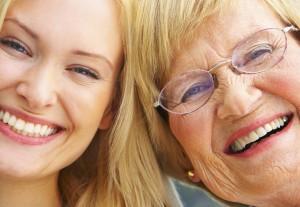 For a conservatively estimated 10 million Americans (85% of whom are women), incontinence of urine is socially embarrassing, physically limiting, or a significant disability. In fact, after psychiatric and neurological disorders, the uncontrollable or accidental loss of urine is the second most common reason individuals are placed in nursing home facilities. The true number of non-institutionalized women who have quietly altered their lives because of accidental loss of urine is actually unknown because they are reluctant to discuss their disability. Women are frequently embarrassed and hesitant to admit their problem to their family, friends or even to their personal physician. Among women, between ages of 45-64, 40% are estimated to have experienced incontinence of urine. Women often perceive that their problem is a normal result of bearing children and getting older, and therefore just cope with it. However, they also limit exercising, dancing, traveling and other activities, which would otherwise require them to be away from nearby toilet facilities. They frequently will change the style of clothes they wear to avoid embarrassment. I want my patients to know that urinary incontinence is a symptom of a condition, which is not normal and usually can be successfully treated to restore normal bladder function.
For a conservatively estimated 10 million Americans (85% of whom are women), incontinence of urine is socially embarrassing, physically limiting, or a significant disability. In fact, after psychiatric and neurological disorders, the uncontrollable or accidental loss of urine is the second most common reason individuals are placed in nursing home facilities. The true number of non-institutionalized women who have quietly altered their lives because of accidental loss of urine is actually unknown because they are reluctant to discuss their disability. Women are frequently embarrassed and hesitant to admit their problem to their family, friends or even to their personal physician. Among women, between ages of 45-64, 40% are estimated to have experienced incontinence of urine. Women often perceive that their problem is a normal result of bearing children and getting older, and therefore just cope with it. However, they also limit exercising, dancing, traveling and other activities, which would otherwise require them to be away from nearby toilet facilities. They frequently will change the style of clothes they wear to avoid embarrassment. I want my patients to know that urinary incontinence is a symptom of a condition, which is not normal and usually can be successfully treated to restore normal bladder function.
The U.S. Department of Health and Human Services estimates the annual direct cost of care for persons with urinary incontinence to exceed $10 Billion, 70% of which is spent for persons who are not in nursing home facilities. Over one-third of the female sanitary pad market is for coping with incontinence of urine and not menstruation. Product advertising frequently focuses on coping or hiding the problem rather than education and treatment. Regardless of the cause of urinary incontinence, this problem can be cured or significantly improved in most cases.
In women, the most common type of urinary incontinence is called urinary stress incontinence or USI. USI occurs when there is a sudden increase in abdominal pressure during certain activities such as laughing, coughing, sneezing, running, bending, lifting, etc. The primary cause of the problem is a weakness of the pelvic tissues (called prolapse), which normally supports the bladder (called cystocele) and its sphincter. The amount of urine loss with each episode of stress, varies with the degree of weakness, the volume of urine in the bladder, and the intensity of the abdominal pressure. The correction of USI is usually surgical restoration of the prolapse supporting pelvic tissues to a normal position so the bladder sphincter mechanism can function properly.
Another type of urinary incontinence is urge incontinence, in which women perceive the urgent need to urinate, rush to the bathroom, and fail to get there in time. The amount of urine loss can vary with the cause of the urge, the volume of urine in the bladder, and the strength of the pelvic tissue. Urgency and urge incontinence are often associated with frequent urination (called frequency) and getting up at night to urinate (called nocturia). Women who regularly experience urgency and frequency, with or without nocturia, have what is called urinary urgency syndrome, with or without incontinence.
The causes of urinary urgency syndrome can be both physical and non-physical. The most common physical cause is infection of the bladder (cystitis) and/or urethra (urethritis), and it is corrected with treatment of the infection. There are other causes such as chronic inflammation of the bladder, polyps or tumors and certain medications. When no physical cause can be found after a complete medical evaluation, the cause is usually a result of a learned habit. Treatment may include medications, bladder retraining programs and pelvic floor muscle exercises (Kegel Exercises).
Mixed urinary incontinence is a combination of both stress and urge incontinence. Often a woman experiencing USI “learns” that if she empties her bladder more frequently, she will be less likely to leak as much urine. Unfortunately, over time the awareness of having a “full bladder” occurs with an ever-decreasing capacity of urine, and she will urinate at more frequent intervals. When the stress component of her incontinence is surgically corrected, she can then retrain her bladder so she will choose when to go to the bathroom. In postmenopausal women, Estrogen replacement therapy will improve the elasticity of the vagina, bladder and urethral tissues, and improve both stress and urgency symptoms.
There are other less common, but important types of urinary incontinence:
Overflow incontinence is a frequent spilling of small amount of urine when the bladder is over-distended, and can occur with certain medications, after pelvic surgery or trauma.
Reflex incontinence is the loss of urine when the person is completely unaware of the need to urinate, such as while sleeping or washing their hands. This type of incontinence may indicate an underlying neurological disorder.
The first step in correcting urinary incontinence is sharing the problem with your physician. Before your visit, you will be given a “Patient History for Urinary Function”. This form should be completed prior to your office consultation. You may also be given a two-day “Voiding Diary” to record the amount of liquids you drink and the number of times and amount you urinate during the day and night. You will also list the circumstances under which you regularly experience urinary urgency or incontinence. After your patient history, physical examination and voiding diary is completed and reviewed, simple office tests are performed which will further identify the primary cause of your incontinence. Once the cause (or causes) is determined, the proper treatment and alternative will be recommended and explained.
Treatment begins with having a thorough understanding of normal urinary function, the cause of your urinary problem, and your treatment alternatives. Successful treatment is a patient-physician team mission, and is an achievable goal.
Contact Dr. Gordon Gunn today at (714) 912-2211 to schedule an appointment.
Dr. Gordon Gunn also proudly serves Buena Park, La Mirada, Yorba Linda, Diamond Bar, Walnut, and surrounding areas.
 One of the main priorities for Dr. Gordon Gunn is to provide a safer alternative to traditional open surgery by offering Gynecology Robotic Surgery. This approach is used when indicated and whenever possible based on the disease we are treating, the patients’ anatomy, and the overall medical condition of the patient. Gynecology Robotic Surgery offers the following benefits to our patients:
One of the main priorities for Dr. Gordon Gunn is to provide a safer alternative to traditional open surgery by offering Gynecology Robotic Surgery. This approach is used when indicated and whenever possible based on the disease we are treating, the patients’ anatomy, and the overall medical condition of the patient. Gynecology Robotic Surgery offers the following benefits to our patients:


 Updated Information That Could Save Your Life
Updated Information That Could Save Your Life

